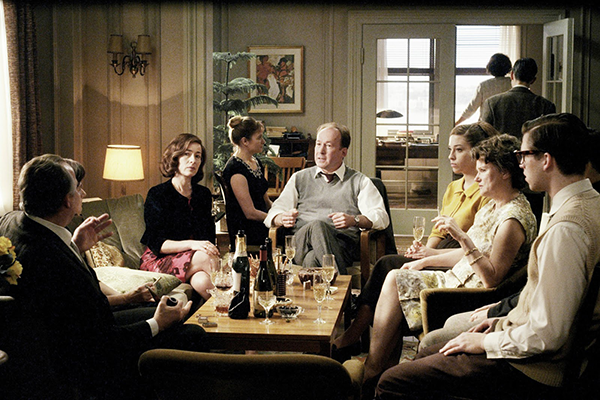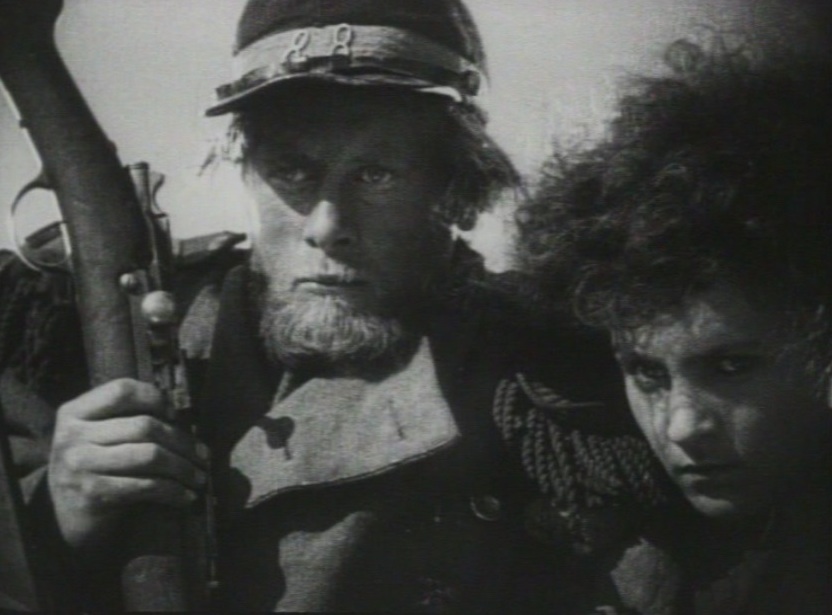
Kabul Airport
Oscar Wilde is quoted as:
“Life imitates art far more than art imitates Life.”
In at least some cases art imitates life and then life imitates art. This would seem to apply to the scenes of chaos and desperation as the USA and its allies leave Afghanistan. A number of commentators have recalled the scenes of chaos and desperation as the USA left Saigon in 1975. The parallels between these two events are limited. Vietnam saw a National Liberation Movement end the US invasion and occupation. The US invasion and occupation of Afghanistan has been ended, at leas tin part, by a combination of religion and tribal cultures.
Joe Biden announces that the US is giving up ‘remaking’ nations. However, only a few radical commentators have actually reminded the US and its allies that their imperialist actions were doomed to end in failure. The advanced capitalist states on either side of the Atlantic Ocean continue to attempt to impose their interests and values on oppressed people and nations. Presumably we have not seen the last such evacuation.
Meanwhile some tyro film-maker is likely already mulling over a cinematic narrative representing these dramatic scenes. Presumably it will in some way mirror the existing movies that have dramatised similar stories and images. The article below discusses a series of such films and the way that they fail to address the imperialist adventures of real-life.
Reports from the ‘Third World’!

This article was written in the 1990s as a study of a cycle of films that predominately featured in the 1980s. The article uses the term ‘Third World’, a problematic term. What is being discussed are the experiences among the oppressed peoples and nations. However, ‘Third World’ was a common term at the time and frequently figured in the comments on these films. As is often the case it did not always carry the same meaning: but a common usage was that ‘1st’ meant advanced capitalist countries; ‘2nd’ countries identified as socialist; ‘3rd’ countries under colonialism or neo-colonialism. In that sense the films I discuss are ‘1st’, and the targets are ‘3rd’. Note also this is not the same as the terms used in Third Cinema. The films I discuss below are all part of the dominant cinema.
I tried to publish this article several times and failed. So to the Blog: because it is quite long I am posting it in chapters.
The Back-Story
The depiction of those exotic lands beyond the imperialist homelands is a long established stock in trade of European and North American films. From the earliest days of the movies their makers have titillated audiences with images of the “dark continents”, the “strange, different peoples”, and their “unusual, bizarre, and often violent” cultures. Over its century of history and development the dominant cinema, sited in those capitalist countries lying either side of the Atlantic, has been an important source for the preconceptions and prejudices held by the mainly white populations of the major imperialist powers. The heyday of this imperial cinema was in the 1930’s. Then, in both England and the United States, a steady stream of cinema goers watched films like Sanders of the Rivers [UK 1935], in which the calm but authoritative white colonial administrator dominated the loyal black chiefs and the black dissidents who dared to oppose him. Or they sat through Gunga Din [US 1939] in which the equally calm, but much more dashing army sergeants, with their sycophantic Indian underling, defeated the black and malevolent rebels on the frontier. These films presented unquestioningly to the audience the values which expressed the economic and political dominance of white Europe over its black empires. This viewpoint was viciously racist, regarding all black, yellow, brown and red peoples as intellectually inferior, prone to unthinking violence and in need of both stern supervision and clear guidance. By 1945 a slight change is visible. In Men of Two Worlds [UK 1946] the central figure is a black musician, Kisenga [Robert Adams], but, although educated in Europe, he is still not totally free from the influence of superstition. At the crisis point of the film his life is saved from the menace of a ju-ju when the villagers sing Kisenga’s own music, but the choir is organised by the white district officer. When the same tribe move off to the happy ending in a new, tsetse fly free village, it is a home selected, organised and ruled by the white colonial system. The independence the film attributes to the black African tribe is strictly circumscribed. And the representation of black people is only less obvious in its racism, in the supposition of their superstitious ignorance and childlike misunderstanding of the modern world.

The Wilby Conspiracy
Such a film provided a reflection of changing economic and political realities as colonialism gave way to neo-colonialism. And as direct rule was replaced by the home grown puppets, and military occupation by economic diktat, so the fictional world of film acquired its black leaders (The Wild Geese UK 1978), and the black and white co-operative venture (The Wilby Conspiracy UK 1975). By the 1980’s the sympathetic portrayal of black heroes and heroines from amongst the oppressed peoples was approaching a norm, and thus we enjoyed an abundance of films which centred on the so-called ‘Third World’, and appeared to view it in a supportive way. I want to argue that many of these liberal (a common description) movies, whilst they appear to be a great advance on the 1930’s, are under the surface still imperialist and racist. They have merely changed the form of representation in line with the changed but continuing exploitation of the oppressed peoples. I have selected a cycle of films that appear to share not only this value system but also a common narrative structure, plot devices and representations (see references). In each of the films the audience is presented with a story of oppression and resistance sited in a ‘Third World’ country. The guide to this story is a westerner, a white, male journalist. He arrives, becomes involved, in some way helps the oppressed in their struggle, then he leaves. In the course of the struggle both innocents and/or a leader die in the cause. These stories are thus melodramas of protest, with
“the blood of the martyrs sewing the seeds of resistance” (Michael Walker in Melodrama and the American Cinema in MOVIE Issue 29/30, 1988).
The melodrama of protest is the classic structure for depicting and condemning oppression and for eliciting sympathy and defiance on behalf of the oppressed. In such structures we are encouraged to identify with victims of oppression, the outrage engendered by their suffering moves us to support defiance and resistance to the oppressor, [One Flew Over the Cuckoo’s Nest, US 1975 is the example that has enjoyed the greatest box-office success]. Yet in the movies discussed below the oppression is suffered uniformly by black people whose rescue is effected by whites. The linchpin of these stories is the intervention by the western journalist. Where there is a success, the actions of the journalist are a key factor; where there is defeat the journalist leaves, taking the narrative with him. It is an image of liberation wholly centred on the viewpoint of the west. It directly contradicts the ideas generated in the struggle by some of the most noted leaders involved in Liberation, like Steve Biko, Pablo Freire and [most importantly Franz Fanon]. Yet the films use some of these icons as part of the story-line; Steve Biko is supposedly the subject of Cry Freedom (UK 1987) ; Salvador, USA 1985) features a literacy class obviously modelled on Friere’s work.

Cry Freedom
The fact that they treat of such historical figures and of well-known historical events is yet another problem. Regardless of disclaimers (like those made by Richard Attenborough at a screening in 1987) audiences are encouraged on entering the cinema to see the films as dramatisations of real-life events. The publicity for the films emphasise this angle; The Year of Living Dangerously (Australia 1982) poster tells us “Jakarta May 11 1965”; and Cry Freedom’s marketing laid great stress on the story of a friendship between two men, one still living. The latter’s marketing was assisted by two TV programmes about Steve Biko and five freshly printed paperbacks on him or Black Consciousness. The use of the media as a central device adds to this pressure. The films are full of recognisable media techniques, photographic stills in Under Fire, teleprinter titles in Cry Freedom and the TV news’ rhetoric of The Year of Living Dangerously and The Killing Fields (UK 1984). Whatever the intentions of their makers, these films to greater or lesser degree blur the distinctions between ‘fact’ and ‘fiction’. Yet, while not all the film’s content is total fiction, neither is much of it an uncontested record of events.
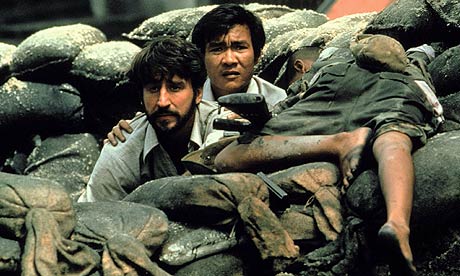
The Killing Fields
Most importantly the films present themselves (in the manner of classic narratives) as unproblematic, disguising their exaggeration, compression and distortion of events with a seamless development built up by sophisticated techniques of story telling, of use of camera, of sound. The position they offer the audience defines good and evil, hero and villain, right and might without the difficulties of counter argument. They are entirely innocent of an awareness of their own set of values, not necessarily shared by others. They certainly fail to reflect the very different values held by many people among the oppressed they claim to sympathise with and support. Whilst working within mainstream cinema conventions, it is clear that these films are not to be treated as mere entertainment. Many of the reviews discussed both their ‘political message’, and their ‘historical veracity’. They have an overt political content unusual for commercial cinema. This was probably one factor in their limited box-office success, only The Killing Fields was an international hit. But while they did not equal the audiences for Spielberg-style movies, they did appeal to a specifically critical group of viewers. In cinema, and later on video, cable and television, they were marketed to a politically literate audience. UIP, for example, commissioned a survey on the awareness of apartheid in the USA before the production of Cry Freedom. The media attention connected with the films’ overt political projects included TV programmes exploring aspects of their version of history. The Killing Fields is a notable example and its title has entered popular language as a clinched description. Yet, with few exceptions, this critical discussion has not analysed how the film’s entertainment conventions affect these political discourses. The cycle appears to end, or at least change its form, by the end of the 1980s. The explanation for this would seem to lie in the internal collapse in the Soviet Empire and the consequent unfettered policing of the world by the USA. The Gulf War is the most notable and vicious example of such policing. With no imperialist power remotely approaching its dominance, the USA ordered, cajoled and bullied a line-up of states into the assault on Baghdad. This included both ’Third World’ states and Arab states, the much-vaunted ‘third way’ appears to have collapsed without Soviet support. The cultural effects of these changes go beyond the cycle I describe, for instance, into ’Third Cinema’. So in a subsequent essay I shall detail examples of both ‘third cinematic’ treatments of these stories, an alternative: and examples from the mainstream in the 1990s, which, I believe, have important differences.
THE NARRATIVE.

A shot and Russell Price will pick up the gun
The clearest generic expression is found in Under Fire, a 1983 film from the USA. Photojournalist Russell Price (Nick Nolte) goes to cover the war against Somoza’s dictatorship in Nicaragua. He is an ace professional photographer, announced by his colour photo cover on Life magazine, and, “I’m not taking sides, I take pictures..” However, Nicaragua is different, so he breaks his rules – by taking a photograph of the dead Sandinista leader Rafael, in order to convince the world that Somoza has not succeeded in eliminating him. Strengthened by this device the Sandinista’s army of freedom approaches the capital. Russell again takes a picture of a dead man, his journalist friend Alex (Gene Hackman), shot by Somoza’s National Guard. Pursued by Somoza’s army, his girlfriend Claire (Joanne Cassidy) and a young Nicaraguan help by carrying the roll of film to Russell’s hotel, and the appearance of the story on TV signals the end for Somoza, who flees the country. Russell and Claire leave after watching the triumphal entry of the Sandinista into Managua. The story’s structure clearly shows how the film presents this white, male, western journalist as the key to the success of the struggle. In the course of the film we see his conversion from a detached professional to committed sympathiser. It is his actions that drive forward both the story-line and the filmic struggle against oppression. Thus at the film’s end he can leave having help make possible liberty and democracy, both ideals that the western media regularly presents as the preserve of the west.
In Cry Freedom it is the editor Donald Woods [Kevin Kline] who fulfills this role. At the end of the film we see him flying from South Africa carrying his book which will tell the world about Steve Biko and his death, the implication being that by this act change will be bought to the suffering masses of South Africa. This point is confirmed with the roll call that follows of black activists murdered by the Apartheid State, of the black leadership dead or imprisoned. The only remaining hope is our planeload of white liberals.
In Circle of Deceit (West Germany/France, 1981), Salvador and War Zone the journalists leave peoples still divided and suffering, but they also leave with a scoop, either a news-story or unique film footage. It is as if only by telling the story does this suffering really exist. In The Year of Living Dangerously the hero, Guy Hamilton [Mel Gibson], also leaves Jakarta bloody and under military dictatorship, he carries no story but the equal prize of a beautiful heroine. Thus the 1960 slaughters of the archipelago are converted into a darkly romantic backdrop for these media tourists. In The Killing Fields Schanberg leaves and returns, to witness the escape of his Kapuchean buddy from imprisonment. In this version the “Third World” is graphically depicted as a place of violence and suffering, from which not only westerners, but the indigenous people flee.
What is common about all these story-lines is the negative presentation of the “Third World”, from which all the main characters exit, by choice or by death. Of course, oppressed countries are places of poverty, violence and suffering, but in each case these are specific to particular exploitative relations, usually with the very country from which the film’s hero comes. In The Killing Fields its makers specifically chose to play down the role of US military intervention;
“He [Roland Joffe – director] also went to some lengths to strip out any anti-Americanism which inevitably colour any consideration of South-East Asia. He points out that, although the American bombing clearly boosted the power of the Khmer Rouge, the Americans had no part in the murderous ideology which the Pol Pot regime proceeded to implement.” [BFI]
While the CIA’s well-known misdemeanours are featured in Under Fire and Salvador, The Year of Living Dangerously blithely passes over this. A similar problem is found in the absence of any reference in Cry Freedom of the West’s support for the Apartheid regime. What we get is a sympathetic embassy official [Alec McGowan] offering the fleeing Woods’ family “a cup of tea”.
Melodrama frequently waters down the political edge of stories by a concentration on the individual and personal; thus, these films treat the larger questions very selectively. The most positive of the cycle is Salvador where visceral images of violence and death are counterpoised with explicit denunciation of USA policy. However, even here the film in the end comes down to the Yankee point of view;
“I don’t want to see America get another bum rap [the first being Vietnam!]”.[the film’s hero Richard Boyle].
This viewpoint is endorsed by the film when in its later stages, it equates guerrilla ‘atrocities’ with those of the Salvadoran army.
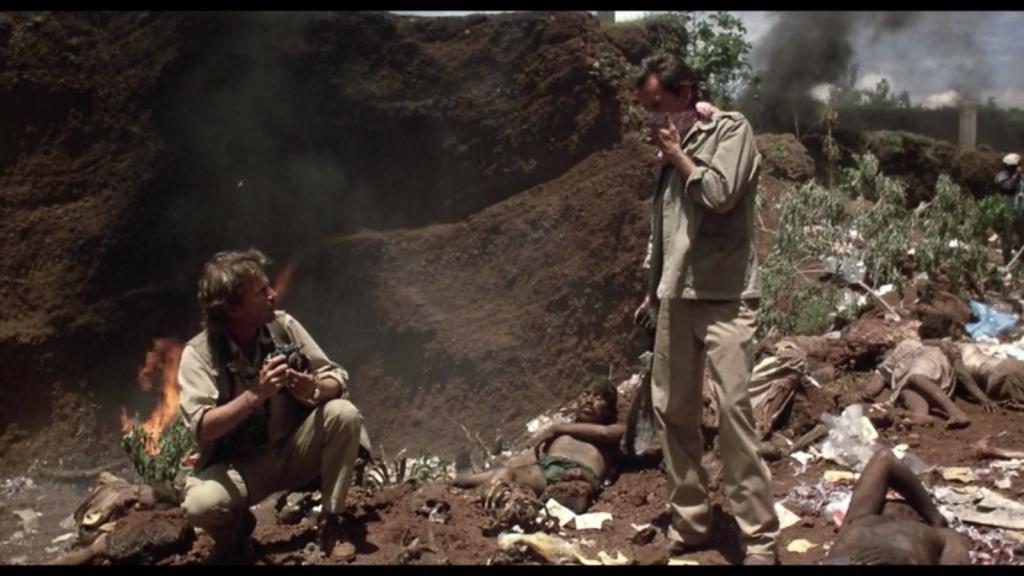
Reporters in Salvador.
The same simplification applies to the little political analysis found in the films. In Under Fire Russell and Joanna attempt to explain to Alex their sudden active sympathy for the rebels. To do so they break curfew and show Alex a statue of Somoza in the main square, explaining it is actually of Mussolini, bought cheap in Italy and subjected to a head transplant. This feeble equation of very different fascists regimes entirely misses the point about the political economy of Nicaragua. Hollywood has always had problems delineating political positions, hence the device [common to such films] in Cry Freedom of turning Biko’s explanation of Black Consciousness into a series of edited phrases dwarfed by the photogenic location. In none of the films is the viewer ever given a substantial detailing of the character’s political positions; we are expected to judge them by their actions.
THE MASSES.
Black people in these films are associated with lack of autonomy and the experience of being victims. Worse, the films uniformly see these oppressed countries as sites of mindless violence. Thus The Killing Fields publicity hand-outs state;
“The war unleashed an underlying savagery in the Cambodians that had lain dormant for centuries. Indolent, gentle and smiling the Khmers may have seemed, but as Bernard-Phillipe Groslier, the distinguished French archaeologist observed: ‘Beneath a carefree surface there slumber savage forces and disconcerting cruelties which may blaze up in outbreaks of passionate cruelty.” [BFI]
Stereotyping peoples in this way inevitably leads to the narrative flight that ends most of the films. Historically westerners have fled many of these countries, quite often chased out by the oppressed. But a supposedly sympathetic view should offer something more.

Beirut in Circle of Deceit
An equal penchant for savagery typifies the films set in the Lebanon. A gunman casually offers to shoot a passer-by by for photojournalist Hoffman [Jerry Skolimowski] in Circle of Deceit. The virtual remake, War Zone, has an Israeli Officer trying to warn the Palestinians of the Camp massacres by the Phalangist. The violence is attributed to the oppressed, western [e.g. Israeli] violence glossed over. What the cycle of films fails to offer is any understanding or explanation for the popular support and participation these struggles enjoyed. In Palestine the Intifada was driven forward by the mass of the people, with the PLO struggling behind. Similarly, in the black African townships of the late seventies rebellious youth was far more radical than the formally organised movements like the ANC. No such ethos is apparent in these films. The masses provide cheering, suffering or dying support for the chosen individuals celebrated by the media: suitably cleaned up and dressed up, as in the Swot demonstration sequence from Cry Freedom. The self-activating action preached by Biko, Freire and others never surfaces.
GENDER.

Salvador, the woman’s typical place!
If black people get a raw deal in these movies so do women, even those selected as heroines. They are very much the emotional and political handmaidens of the male heroes. In The Year of Living Dangerously it is Jill [Sigourney Weaver] who makes the mistake, Guy who discovers it. Claire in Under Fire reports all the stories that Russell photographs, but while we see his photos we never hear her stories. Most markedly in Cry Freedom we have a powerful scene where Donald and Wendy Woods [Penelope Wilton] argue over his decision to leave South Africa; her arguments are about home and family, his about politics. Yet it was Wendy Woods who first took an interest in Black Consciousness and Steve Biko; her feminism made her more open to these new and threatening ideas than her husband (Farrar, 87). Some awareness of the problem does creep into the better films, thus in Salvador the film opens with the enforced leaving of the USA of Boyle’s Italian wife [Maria Rubell]; at the film’s end his new women, Maria [Elpedia Carrillo], is dragged from a bus by US immigration – obviously the USA is a bad place for black women. But even here the casting of Carrillo, who played a similar role in The Honorary Consul [UK 1983], reinforces her image as an object for Boyle and other men. Overall, these films never get to grips with the subordination of their women, despite their supposed fight against oppression.
THE MEDIA.

The Killing Fields
The subjects of this film cycle are very much those on the agenda of the western media; South Africa, Latin America, the Lebanon and Kampuchea. Indonesia gets coverage, but not East Timor; and the 30-year struggle in Eritrea failed to make it. Vietnam, where the imperialist power lost, has films with reporters but they either fall outside this cycle or treat the journalists differently. Thus The Green Berets (1968) has the journalist validating the military. And in Full Metal Jacket (1987) the reporter is actually serving in the US Army.
Even in the countries featured there is a problem. The critical strand in these movies is directed at the media, not the imperialism it serves. Early in Cry Freedom Steve Biko criticises the affluent life of Donald Woods and invites him to see the reality of the Black township. Similar contrasts are made regarding Schanberg and Boyle. The style of the films re-inforces this, comparing the luxury hotels of the journalists with the stark poverty of the indigenous people. Russell Price and John Cassady [John Savage, the photojournalist with Boyle in Salvador], not only incessantly drive round in cars, but on every occasion of death and destruction leap for their cameras. This is at its most repellent as Boyle and Cassady discuss taking photographs against a grisly pile of murdered Salvadorans. Its extreme symbol is Guy Hamilton, whose blindness to the local world he passes through is epitomised by the loss of sight in one eye. This film is full of characters who hide behind dark sunglasses, their vision impenetrable to the onlooker.
Such criticism fails to grapple with the actual role of the western media, whose relationship with the oppressed is not just distant or unsympathetic, but actively justifies imperialist relations. Both the recent Gulf War and the occupation in Somalia are graphic demonstrations of this. Moreover, the films let the heroes off the hook by a melodramatic conversion that turns them into good guys. So Russell Price fails to tell the Sandinista of a hidden US mercenary, who, minutes later, shoots a youth in the back. For the first time in the movie Russell reaches not for his camera, but a gun. Guilt has made him change sides. In the same way Woods and Boyle change their allegiance, and Schanberg attempts atonement. Not one of these acts addresses the actual social relationships that engender the oppression, or that are likely to end it.
Genre and style
The films tend to follow the conventions of mainstream cinema. One of the influences on some, but not all, of the film is film noir. This is especially noticeable in Circle of Deceit, The Killing Fields, Salvador, Under Fire, War Zone and The Year of Living Dangerously. Circle of Deceit and The Year of Living Dangerously both employ a narrative voice and a sense of the ‘confessional mode’. All these films use chiaroscuro and the contrast between light and shadow. In these, and indeed to a degree in the other films, the hero ventures into a world of chaos from which it is uncertain whether or not he will merger safely. In fact uniformly we have the ‘seeker hero’ who survives, though not always unscathed. Strictly speaking there are no femme fatales. However, there are siren objects that draw the hero into chaos. Quite often this is the journalistic ‘pot of gold’; an interview with a ‘terrorist leader’ in Circle of Deceit; the iconic rebel leader in Under Fire; a possible coup d’etat in The Year of Dangerously. The noir style reinforces the tendency of these films to represent lands and peoples as ‘other’ and threatening.
Other Genres
Many of the plot lines and motifs appear in other Hollywood films addressing the Vietnam War but which fit into different genres and whose values are more conservative or even downright reactionary. The key example here is The Deer Hunter (1978) which is essentially a war movie; a genre which Andrew Britton points out seems incapable of actually addressing the values and interests that drive any particular war. The Deer Hunter falls into three parts. The opening is set in a steel town and a community bound by an Ukrainian Heritage. Whilst much time and representation is spent on the community culture the key point here is the support given by this once migrant community to US dominant values and the war against Vietnam. These values are found most clearly in a trio of friends who have volunteered to serve in Vietnam. At a wedding celebration they offer awe and respect to a Vietnam veteran; though he seems fairly disillusioned. What might be described as an idealogical echo is the characters love of US gun culture. In a hunting sequence this is represented in what seem to be Wagnerian dramatic terms.
The second part follows the trio as they arrive and fight in Vietnam as part of the US occupation forces. The values ascribed here can be summarised as an inversion of reality. The recorded instances of US G.I.s playing Russian Roulette with Vietcong prisoners is here turned on its head as the film displays the Vietcong forcing US prisoners to play Russian Roulette with each other. Even by Hollywood standards this is fairly vicious racism.
In the third part we witness one surviving member of the trio return to Vietnam in the final stages of US military collapse and withdrawal. Here Russian Roulette re-appears as a gambling game of the Vietnamese. The US buddy dies in such a den of vice. The film ends as his body is returned to the USA and members of the community join in ‘God Bless America’ around the grave. It seems that if God actually exists in any form recognised by existing religions that he would not bless the imperialist USA. But in dramatising the Vietnam invasion and war Hollywood is impelled in some way to validate the flight from that country. This is an aspect of the war that US films have to try and negotiate; and there are a number of titles that address the contradictions and traumas within the USA whilst ignoring those in Vietnam.
Alternative films
There are other western film with a sharper political edge. One of the earliest was Costas-Gavros’ Missing [1982] about the US backed coup in Chile. Here the hero is not a journalist, but a father seeking his lost son. While the film is powerful both on the vicious repression and US involvement, it avoids the issue by its failure to identify Chile in the text. Circle of Deceit is an art-house film, with a fittingly ambiguous narrative. However, despite lacking a Hollywood style closure at its end, it does share the negative representations of the mainstream films. Some other independent productions grapple more successfully with an alternative set of values.

Hidden Agenda
Hidden Agenda (UK 1990) has an investigation by lawyers [rather than journalists] of a ‘shoot to kill’ incident in the occupied north of Ireland. Here the media devices appear in the shape of tapes, photographs and reports. The film does point to the British occupation of the six counties in northern Ireland, but it fails to grapple with the real issues. Republicanism and Unionism are reduced to stereotypes; the fears of the plot are mainly about the British State, not British colonialism. What the film does do is centre on a woman as the narrative figure fighting oppression. This gives a political edge, to both the story and the characterisation, missing from the main cycle. This film also has a touch of the noir.
Another fine protest melodrama, the Canadian Diplomatic Immunity (1991), also uses gender to increase its political edge. In the flashback by a journalist we hear the story of a woman diplomat Kim [Wendel Meldrum] in El Salvador; she tries to use an aid project to really help the ordinary local people, mainly women and children whose husbands are dead or imprisoned. By the climax of the film she is forced to choose between her western aid methods and direct action by the people themselves. In a moving sequence she joins them in a besieged church, and with the western media, witnesses the state’s and the army’s capitulation – the people are returned to their own village in guerrilla-occupied territory. The final twist sees her Salvadoran soul-mate Sara [Ofelia Medina] executed and her own exit from El Salvador and diplomacy. Yet even here, as in Hidden Agenda, the politics of liberation receive little serious consideration, and the film plays to its audience through the centrality of the Canadian heroine and her English-speaking middle class friend. The film’s very concentration on gender means that it fails to give due attention to anti-imperialism. All three films fail to break out of the dominant mould.
For films that address these struggles from a radically different perspective we need to turn to the oppressed peoples themselves. While many utilise indigenous narrative forms to tell their critical stories, a number have made good use of the melodrama of protest format. A Place for Weeping (South Africa 1986) is one of a number of films produced by Anant Singh and directed by Daniel Roodt. The films tend to a reformist stance but are notable for engaging with the struggle of the oppressed black majority under the Apartheid State. In this film an Afrikaan farmer, out on the remote Veldt, beats one of his black workers to death. His colleagues and family are cowed, but one local woman, Grace (Gcina Mhlope, tries to persuade them to report the murder to the police. Into this situation comes journalist Philip Seago (James Whylie), sent out in the sticks to cover a story about ‘faction fighting’ amongst Zulu and other black communities. This seemingly conventional plot situation is undercut by Seago’s ineffectualness in assisting Grace and his naive trust in Afrikaan officials. And then the armed ‘faction’ turns out to be armed rebels planning to wage conflict against the white racists. There is a scene where its leader and Grace argue about armed versus peaceful struggle. By the film’s climax Seago has been badly beaten up by the local farmers and Grace and her one witness murdered. The final scene shows the farmer’s car halted by the armed black rebels. There is the sound of a gunshot as the screen goes black. A powerfully different moment from the mainstream dramas.

Mapantsula
One of the most interesting filmic alternatives was made in South Africa in the same period as the above film and Cry Freedom, Mapantsula (1988) deals with life in the black townships, a township rebellion, and the treatment of black people by the South African State. It is also centrally about Black Consciousness, allowing one to read any number of parallels with Attenborough’s anti-apartheid movie. The film’s title translates as ‘wide boy’, and tells the story of a small-time crook in a complex flashback structure, so that the audience is only able to slowly unravel the plot.
Much of the film is set in a police detention block, where it is apparent that the political prisoners despise the hero, Panic [Thomas Mogotlane]. Gradually we discover how Panic is drawn into township resistance as his girlfriend Pat [Thembi Mtshali] becomes politicised. Towards the end of the film we watch as Panic, against the mores of his trade, helps in a mother’s search for her child, probably murdered in a police round up. In this way the film involves the audience in Panic’s growing commitment to Black Consciousness. In the final scene Panic, though threatened with prison and death, says no to his white captors and their inducements to act as paid informer. It is a gesture of suicide, but also of black solidarity. Having followed Panic through his trials and his conversion I find this moment one of great uplift and emotion [it is also strongly reminiscent of Eisenstein’s Strike (Stacha USSR 1924), and the flashback structure would seem to be a modern version of Eisenstein’s precepts for montage and the soundtrack follows, in part, the behests of the Sound and Image manifesto of 1928].]. What is equally important is the force of the moment, the audience know with Panic what his captors do not; that the video screened by the police as incriminating evidence is actually evidence of his conversion. In this way the changes in Panic are given a political context. Mapantsula was made covertly by black people in Soweto. The film’s viewing in Azania was limited to video with an age restriction on the grounds,
“younger viewers lack the ability to distinguish between propaganda and all the relevant facts of the situation.”
Of course, all the films discussed in this article are propaganda in the sense given by common usage], but that is a fact rarely admitted by the makers, the censors or the media critics who tend to discuss such artefacts at some distance from the class struggle reality which the people involved experience. As propaganda in the socialist sense (a complex treatment for engaged audiences] Mapantsula can be justly criticised on several points, most noticeably on its failure to deal with the different political tendencies in the South African struggle; differences which have been a crucial factor in the direction of that struggle. However, even with its limitations, Mapantsula is political light years away from Attenborough and company.
So are the many other fine films from Africa, Asia and Latin America. Unfortunately, the nearest an audience often gets to them is in some scene or motif lifted by a western variant. Both Under Fire and Salvador use sequences which certainly look modelled on the earlier work of the revolutionary film-maker Jorge Sanjines [in particular The Principal Enemy / Jatun auka 1974 ]. At least television, in particular Channel 4 has made some recompense by screening such films for the late night audience. One of the more progressive activities liberal cineastes could perform would be to assist these films to a wider audience. When this point was put to Sir Richard Attenborough by a young black woman at a London Film Festival screening of Cry Freedom, he replied
“it was no use showing films in an art house cinema to two men and a dog” (Attenborough, 87).
He would do well to note that despite censorship films like Mapantsula have enjoyed large, popular audiences.
Sanjines writes in the Theory and Practice of a Cinema with the People,
“We can no longer make films that, though they may look upon the culture of our peoples with respect, actually prevent them from fighting back. Our work must not only be in support of the people, sympathetic in parallel fashion, but it must also enter into dialectical interaction with them, because culture and tactics are woven together to form the strategy of the anti-imperialist struggle.” (Sanjines, 1989).
Sanjines and his comrades also build on the practice of Eisenstein and the revolutionary soviet filmmakers. Like them their film practice includes the screening and discussion of films with the workers and peasants, using among other instruments, a portable generator. Watching films like Attenborough’s in the new multi-plex may be very comfortable, but the work of film-makers like Sanjines is better for your mental health. Other examples use the tools of media investigation but remove the western journalist figure; freeing themselves to suggest other approaches to investigation. A powerful example from Argentina, in the tradition of the New Latin American Cinema, is Buenos Aires Vice Versa [1995]. Daniela and Mario are children of the disappeared. Daniela uses a domestic Hi-8 camera to record the city as it is now, but her filming leads her and us into a series of stories that can only be understood with reference to the violent past. These include an obsessive TV viewer, a blind girl, and an ex-policeman. After an hour of ambiguity Argentina’s past in the junta and the disappearances suddenly assumes centre stage. The climax confronts both that past, the present, and the media’s role between. It is a film that combines what is usually referred to as `Brechtian` narration with an absorbing and emotionally powerful drama.
Foreword and afterword
There are films whose plots fit this cycle but which fall outside the 1980s. The most interesting are two films, taken from the same source, but made years apart: in the 1950s and in the new century. The source is the novel by Graham Greene set in Vietnam in the 1950s, The Quiet American. This was the period when the French were still vainly trying to re-impose their colonial control. Kicked out by the Japanese in World War II they had managed to sneak back with the connivance of the British at the end of that conflict.
The heroic struggle of the Vietnamese people, under the leadership of Ho Chi Mien, is one of the most inspiring and most telling of the anti-colonial struggles of the period. Typically, whilst Greene’s novel treats the French and other transatlantic colonialists with a sardonic gaze, he does not really engage with the Vietnamese struggle. There is a sense of orientalism, as defined by Edward Said, in his original novel. The main protagonist is a typical Greene hero, Fowler, a disillusioned and disengaged British journalist stationed in Saigon. His foremost pre-occupation in his Vietnamese mistress Phuong. Fowler has a romantic view of Vietnam, even though he believes he s not a romantic but a cynical reporter. So he fits into a long line of European and especially English characters smitten by a love of the orient. This stance is also there in his representation of his mistress Phuong. She seems to be a more complex character than Fowler realises. Whilst he treats her as an autonomous character, at the same time he sees her, and the class of women to which he assigns her, as not exactly innocent, but lacking in sophistication. Note in the novel Phuong has very little English and speaks but does not write French,
The key aspect of the plot is that Fowler has his acquaintance struck up by the ‘quiet American’, Pyle. [Note it is Phuong who first describes Pyle as ‘quiet’]. Pyle is a typical Greene yank: naïve, ill informed of the world beyond the border of his country, and full of well-intentioned and misguided illusions regarding the Third World. The drama of the book develops as Pyle takes a shine to Phuong and offers her the marriage that Fowler is unable to offer. These personal relationships are complicated when Fowler discovers that Pyle is a CIA agent [the agency had only just acquired its new name] working with a ‘third force’ inside the South Vietnamese state. The outcome is partly tragic party ironic, again typical of Greene.

Pyle and Fowler – 1958
The first film adaptation was made in 1958 by an independent production Company, Figaro, though United Artists distributed it. The film was written and directed by Joseph Mankiewicz. He also produced the film, though unaccredited, and Figaro was his own production company. Mankiewicz started out as a screenwriter and progressed to direction. His output included 67 script credits, 22 directorial credits and 23 producer credits. He was very active in the 1950s, but there is not really another film in his output that parallels this work. I do not have a sense of why Mankiewicz and his colleagues adapted the book to film, though it was a successful novel. However, given the political climate of the time it does not appear to be an obvious choice for adaptation. The UK release was eleven minutes shorter than the US original but I have not found out what was cut or why.
At the time of the film’s release Greene was extremely critical:
Greene was furious; he called the 1958 film “a complete travesty”, “incoherent” and “a real piece of political dishonesty”. He also spoke of Mankiewicz’s “treachery”.
This was the period following the HUAC investigations of Hollywood and the blacklist was till in operation. Unsurprisingly Greene’s critique of US neo-colonialism was changed and distorted in this film. The US involvement in Vietnam was still mainly covert. However, the dominant political line, articulated in Allan Dulles’ ‘domino theory’ saw US interests in attacking South East Asian liberation movements. Fowler spells out the ‘domino theory ‘ at one point in the book.
The film changes the representation of Phuong, who is played by an Italian actress, Giorgia Moll. Fowler describes her as ‘child-like’ to Pyle and seems to assume that she is both naïve and innocent. Also, Fowler’s indulgence in smoking opium is excised. Pyle is known only as the ‘young American’. This was probably due to Mankiewicz receiving advice from a CIA operative who may have been a model for the character in the book.
In other ways the film follows the main plot of the book. Indeed for the first 100 minutes viewers are likely to find Pyle exactly as Fowler describes him. And as Fowler starts to discover the covert activities the film appears to follow the direction of Pyle’s guilt. Then in a turn-around Fowler is confronted with the ‘truth’. That in fact this quiet American was innocent and was set up by the Vietminh who used Fowler to eradicate him. The supposition seems to be that Fowler’s jealousy of Pyle is the main actor in his death.
One can understand Greene’s response. The resolution is heavy handed. It plays exactly like the sort of endings that were imposed under the Hay’s Code, which in fact was in its last years at this stage. This is a world away from the other film adaptations of Greene’s novels, The Third Man (1949) and Our Man in Havana (1959) where US naivety is pilloried. However, the film is unable to invoke the usual rescue by the westerner. At the film’s end, Pyle is dead, Fowler is guilt ridden and has lost Phuong. But he shows no sign of returning to his home in the west.

Fowler, Pyle and Phuong – 2002
Unfortunately Graham Greene was not around to see the new adaptation of his book in 2002. This is much closer to the original: the plot is closer to the book in greater detail. Brendan Fraser as Alden Pyle is at one the naïve yank in the East but also the action man who is capable of atrocities, bomb explosions that kill civilians. Phuong is much closer to the character in the book, and played by a Vietnamese actress Do Thi Hai Yen. She also has a greater command of English, presumably as an aid to audiences. And Michael Caine’s Thomas Fowler is recognisable as the cynical and also emotional protagonist of the novel.
By the end of the film we know that Pyle and his associates are involved in covert manipulations, which involves bombings depicted in graphic terms. And whilst Fowler’s motivations remained clouded there is not doubt that this CIA group are the sort of destabilising force that would haunt Vietnam for another decade and a half.
As in the book, Pyle dies, and Fowler regains Phuong, presumably to stay indefinitely in Vietnam. The film adds a montage at the close of newspaper articles recording the increasing US military involvement in the war: a point that emphasises more strongly than the novel the neo-colonial activities of the USA. The film, of course, enjoys the benefit of hindsight.
It is worth noting that both films show the influence of film noir. Both films follow the novel in using a flashback structure and the confessional mode. Both make extensive use of chiaroscuro and Fowler himself makes the comment of the conflict between light and darkness. Neither film has a femme fatale, the siren call is Vietnam and the Orient. However, in the 2002 version there is a sense that Phuong acts as a metaphor for Vientnam, beautiful but unknown. In both versions the protagonist descends into a world of chaos. In the 1958 version Fowler is a victim hero, live but dead emotionally. In the 2002 version Pyle becomes the victim hero whilst Fowler remains the seeker hero.
Neither film fits the cycle in that [apparently] the western protagonist does not leave. And neither is the protagonist a heroic character who aids the oppressed. That Fowler aids the Vietminh in the recent adaptation is by their doing and his motivation remains ambiguous. Moreover, the latter film has little sense of a liberation struggle against western colonialism. Like Greene’s novel it is critical of Western colonialism and neo-colonialism without really taking sides. However, it is a long way in political representation from the mainstream films in the cycle.
The ‘ur’ text

One can trace many of the stories and tellings in this study back to one, classical work – Joseph Conrad’s Heart of Darkness. His novella was first published in 1899 and was based on a journey he made in command of a river steamer up the Congo, which was then part of what was euphemistically called the Congo Free State. Even by the standards of European colonialists in Africa the operation that was ruled over by Belgium’s King Leopold II was horrific. Possibly seven to ten million Africans in this territory were slaughtered by the Association Internationale Africaine and Leopold’s Force Publique. And many more were maimed and brutally treated. The behaviour of the European colonialists in the Congo was already known at the time, and became an international scandal thanks to the sterling efforts of another anti-colonial fighter, Roger Casement: murdered by the British State for his struggles to free Eire.
In Conrad’s novella the tale is narrator by a seaman, Marlow, to friends whilst relaxing on a boat moored in the Thames. He recounts a journey up the Congo River and his encounter with an agent of the Colonial company Kurtz. Kurtz is noted both for his success in expropriating ivory from the territory and in the brutality of his methods. It is worth noting that Kurtz was also a journalist before becoming an agent in the Congo. The behaviour of the Europeans is both brutal but they are also characterised by their greed, dissensions and bizarre behaviour. Marlow sees little cohesion among the Europeans in the encampments and as the boat travels up the Congo Dutch passengers fire wildly into the bush on several occasions. Note that Kurtz dies in the Congo but Marlow returns to Britain.
The book is a much studied text and one that has evoked very differing responses. Chino Achebe, the great African writer, described the novella as racist, because it depicted Africa as the ‘heart of darkness’. Achebe’s criticism has a certain amount of justification. The Africans in the novella are denied a voice. However, the book also seems to draw a parallel between the darkness of Africa and the darkness of the colonialist homelands, including Britain. Certainly Marlow was horrified and jaundiced by his exposure to the colonials methods in the Congo. And Kurtz’s last word in the novella are
‘The horror, the horror’.
I tend to the view that Conrad’s writing reflect the prejudices and bias of the time. In that sense his books reflects the racism of the colonialist culture whilst at the same time critiquing the practices which this involved. This is also true of some of the works that follow in his footsteps including some the films studied here.
Conrad’s novella has been extremely influential. To take one example, one can see traces of the earlier work in Graham Green’s The Quiet American. In particular Fowler makes a trip to the city of Phat Diem to observe the war. His experiences on a night patrol carry a strong flavour of the descriptions in Conrad’s work.
However, this earlier masterpiece has not really been addressed by cinema. The most famous adaptation is Francis Ford Coppola’s Apocalypse Now (1979). However, this is a very free adaptation and is some way removed from the source. Moreover, the film is even less engaged with the indigenous people and far more orientalist than Conrad’s original.
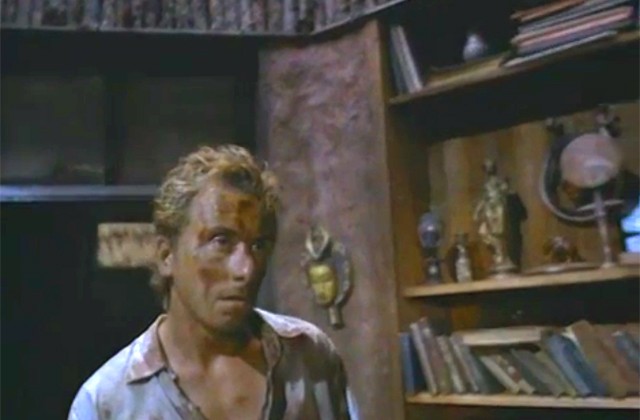
Tim Roth as Marlow
There is a 1993 Heart of Darkness by Turner Pictures. But whilst this film follows the plot of the novella fairly closely it has none of the poetry or comment. This sense is clear in the IMDB comment, “Joseph Conrad’s classic novel about greed and insanity”, which is no way describes the novella. Unfortunately Orson Welles never managed his project on the novel: it would likely have been superior.
There is however an alternative vision to that of Conrad in the film Sarraounia (1986). This was written and directed by Med Hondo; produced by his own company with support from Burkina Faso, Mauritania and France.. The action of the film takes place in the area now occupied by Cameroon and is set in 1899. A French column of troops set out to ‘pacify’ the country, killing, burning and looting. They are finally confronted and defeated by the wily tactics of the Aznas, led by their warrior Queen Sarraounia. However, in an echo of Conrad’s book, the French colonialist also collapse because of their internal dissension and psychotic behaviour.
The film was shot in Techovision and is in Dyula, Peul, and French. I imagine that is it very difficult to see. It had a limited release in the UK by ICA Projects and it was screened in the early days of Channel Four, when the film selection was far more varied than now. This demonstrates the problems of seeing alternative visions. And the 1980s were far better than in 2016 for independent, foreign language films at the cinema.
There is a more recent documentary film on the actual historical events in the Congo Free State, King Leopold’s Ghost: A Story of Greed, Terror and Heroism in Colonial Africa (2006). This is based on the book of the same name by Adam Hochschild (1996). The book has incited some controversy, especially regarding the estimates of the victims of the rapacious rule. The Belgians destroyed many documents when, under international pressure, the area was transferred from the personal misrule of Leopold II to the Belgium State. Undoubtedly there were massive casualties among the Africans from murder, torture, mistreatment and imported diseases. This truly was a holocaust, worse than, but qualitatively little different from the actions of other European colonialists, British, French, German and Portuguese.

Photographic record of atrocities
Yet there are few features or documentaries treating these subjects across the various cinemas: and this applies equally to the earlier holocaust of the Atlantic Slave Trade. The comparison with the film treatment of the several European holocausts is instructive. After a decade and a half of silence that perpetrated by the Third Reich on Jews, Eastern Europeans, Romany and Socialists has seen at least one major film treatment practically every year. Yet the main distinction in the last is that the victims were Europeans. [There were also African victims but they are rarely mentioned: see Ousmane-Sembène‘s Camp de Thiaroye (1988). In other respects, both in the strategy and tactics involved, what occurred in Europe imported the methods that had been developed and honed to brutal perfection in the colonies. So however you characterise Joseph Conrad and his famed novella it would seem that his European readers have moved on little from his day.
FILMS.
Circle of Deceit, West Germany/France 1981, Director: Volker Schlondorf. Script: Volker Schlondorf + David Williamson, Book by Nicolas Born.
Cry Freedom, UK 1987, Director Richard Attenborough. Script John Briley, developed from the book by Donald Woods.
The Killing Fields, UK 1984, Director Roland Joffe. Script Bruce Robinson, story by Clayton Frohman.
A Place of Weeping, South Africa 1986, Director Daniel Roodt. Script Daniel Roodt. Story Les Volpe.
The Quiet American, USA 1958. Director and script Joseph L. Mankiewicz.
The Quiet American, USA, Australia, Germany, France 2002. Director Phillip Noyce. Script Christopher Hampton.
Salvador, USA. 1986, Director: Oliver Stone. Script: Oliver Stone, Richard Boyle, developed from book by R Boyle
Under Fire, USA 1983. Director: Roger Spottiswoode. Script: Ron Shelton, Clayton Frohman.
War Zone. West Germany 1986, Director: Nathaniel Gutman. Script: Hanan Peled. [Deals with the Israeli invasion of Lebanon and the Chatila Camp massacre].
The Year of Living Dangerously, Australia 1982, Director Peter Weir. Script David Williamson, Peter Weir and C. J. Koch from the latter’s novel.
Other Western Produced Melodramas.
Hidden Agenda, UK 1990, Director Ken Loach, Script: Jim Allen.
Diplomatic Immunity, Canada 1991, Director Stephen Gunnarson, script Jim Lucas.
Missing, U.S.A. 1982, Director: Costa-Gavras, Script: Costa-Gavras, Donald Stewart.
War Movie
The Deer Hunter, USA 1978, EMI – Universal Pictures, Director and Story [jointly] Michael Cimino.
Alternatives from the Oppressed Peoples. (Personal choice)
Mapantsula, South Africa 1988, Director Oliver Schmitz. Script: Oliver Schmitz, Thomas Mogotlane.
The Principal Enemy, Bolivia 1971, Directors Jorge Sanjines + the Ukamau Group.
Sarraounia: The Warrior Queen. Mauritania + Burkina Faso 1986. Director Med Hondo. Script Med Hondo.
SOURCES:
Mike Walker in Movie, Issue 29/30. On popular film melodrama, but the best writing on the Melodrama of Protest.
Richard Attenborough’s comments were made at the London Film Festival School screening 1987 and taken down by author. Max Farrar in a 1987 interview with Wendy Woods made the point regarding her politics.
Jorge Sanjines and the Ukamau Group Curbstone Press 1989. Theoretical writings and background on the cinema in Bolivia.
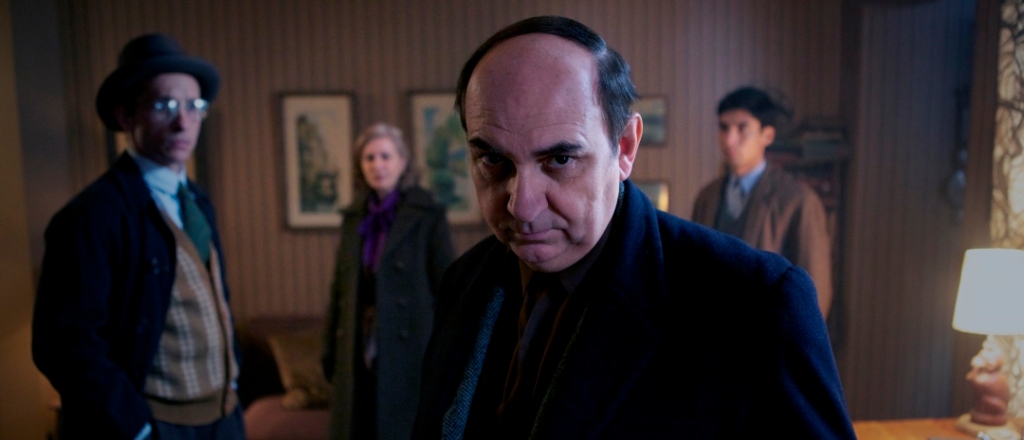



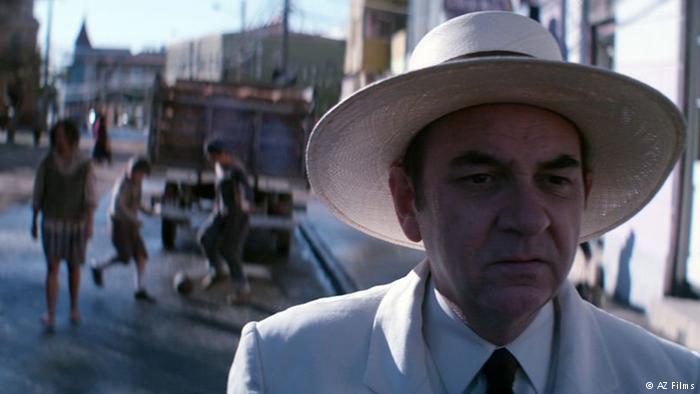



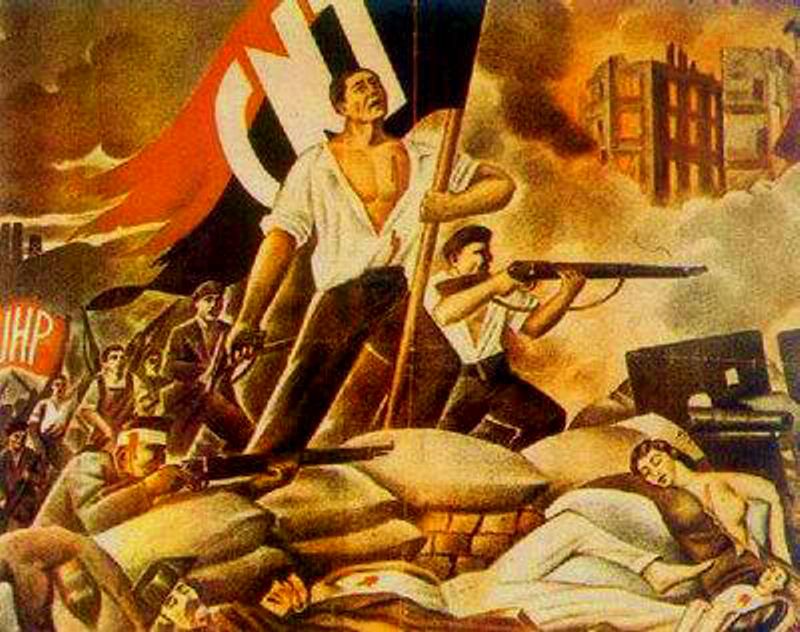


![cntfai4ka[1]](https://thirdcinema.files.wordpress.com/2016/09/cntfai4ka1.jpg?w=454&h=354)


































